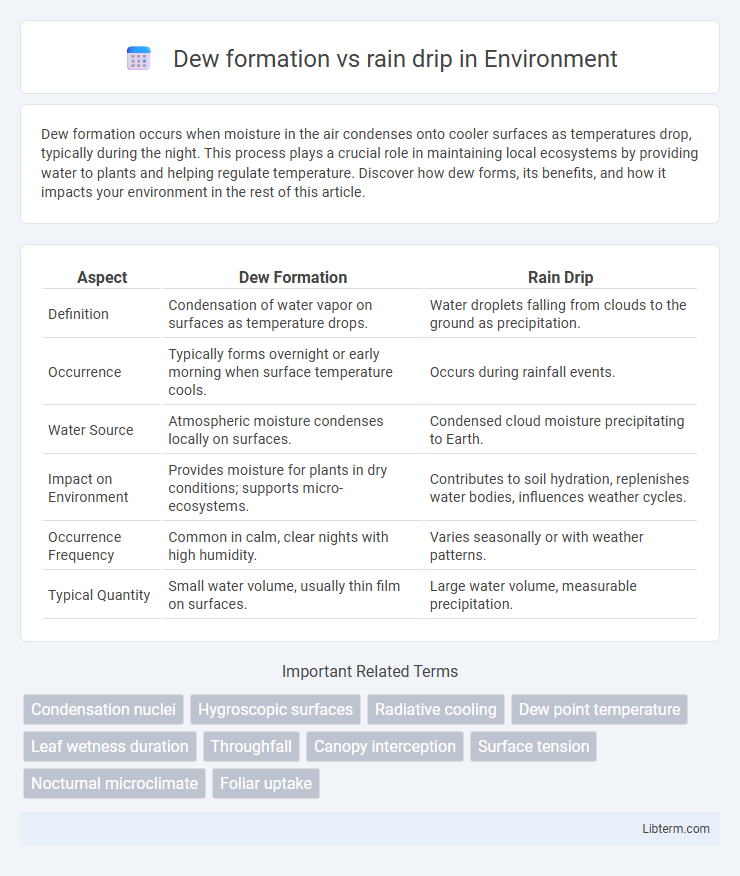Dew formation occurs when moisture in the air condenses onto cooler surfaces as temperatures drop, typically during the night. This process plays a crucial role in maintaining local ecosystems by providing water to plants and helping regulate temperature. Discover how dew forms, its benefits, and how it impacts your environment in the rest of this article.
Table of Comparison
| Aspect | Dew Formation | Rain Drip |
|---|---|---|
| Definition | Condensation of water vapor on surfaces as temperature drops. | Water droplets falling from clouds to the ground as precipitation. |
| Occurrence | Typically forms overnight or early morning when surface temperature cools. | Occurs during rainfall events. |
| Water Source | Atmospheric moisture condenses locally on surfaces. | Condensed cloud moisture precipitating to Earth. |
| Impact on Environment | Provides moisture for plants in dry conditions; supports micro-ecosystems. | Contributes to soil hydration, replenishes water bodies, influences weather cycles. |
| Occurrence Frequency | Common in calm, clear nights with high humidity. | Varies seasonally or with weather patterns. |
| Typical Quantity | Small water volume, usually thin film on surfaces. | Large water volume, measurable precipitation. |
Introduction to Dew Formation and Rain Drip
Dew formation occurs when water vapor condenses onto cool surfaces after temperature drops below the dew point, creating fine moisture layers typically seen on grass and leaves. Rain drip results from precipitation that falls from clouds and accumulates on surfaces, often forming larger, irregular water droplets. Both phenomena contribute to surface moisture but differ in origin, with dew forming through condensation and rain drip through liquid precipitation.
Defining Dew: Process and Conditions
Dew formation occurs when water vapor condenses directly onto cool surfaces, typically during clear, calm nights with high humidity and temperatures dropping to the dew point. This process involves radiative cooling, where surfaces lose heat, causing moisture in the adjacent air to condense as tiny water droplets. Unlike rain drip, which results from precipitation falling from clouds, dew forms locally through surface-atmosphere interactions without precipitation.
Understanding Rain Drip: Origins and Mechanisms
Rain drip originates from the coalescence of water droplets within clouds, eventually becoming heavy enough to fall due to gravity, distinguishing it from dew which forms via condensation on surfaces at night. Key mechanisms involve cloud microphysics where droplets merge and grow, influenced by temperature, humidity, and atmospheric pressure. Understanding this process highlights the dynamic interaction between cloud composition and environmental factors leading to precipitation.
Atmospheric Factors Influencing Dew vs. Rain
Dew formation occurs when surface temperatures drop to the dew point, causing water vapor in the air to condense into liquid on cooler surfaces, heavily influenced by clear skies, high humidity, and calm winds. Rain drip results from precipitation, depending on atmospheric conditions such as moisture availability, cloud formation, and air uplift processes like convection or frontal systems. Temperature gradients, humidity levels, and wind speed regulate the occurrence and intensity of both dew and rain, distinguishing their formation mechanisms in the atmosphere.
Temperature and Humidity: Roles in Dew and Rain Formation
Dew formation occurs when surface temperatures drop to the dew point, causing moisture in the air to condense as liquid droplets, typically in conditions of high relative humidity and clear skies. Rain drip results from precipitation as water vapor condenses into droplets within clouds due to cooling air, influenced by atmospheric temperature and humidity layers. Temperature variations near the ground primarily control dew deposition, while temperature profiles throughout the troposphere govern cloud formation and subsequent rainfall.
Surface Interactions: Where Dew and Rain Drip Accumulate
Dew forms as water vapor condenses directly onto cool surfaces, such as leaves, grass blades, and roof shingles, creating a thin, uniform moisture layer that enhances surface wetness without impact or displacement. Rain drip results from larger water droplets falling and accumulating unevenly on various surfaces, often leading to pooling or runoff due to gravity and surface texture differences. The critical distinction in surface interactions lies in dew's gentle formation through condensation versus rain drip's dynamic deposition influenced by droplet size, velocity, and surface permeability.
Timing and Frequency: When Dew and Rain Drip Occur
The informal sector often lacks legal protections, social security, and minimum wage guarantees, exposing workers to exploitation and poor working conditions. In contrast, the formal sector provides regulated employment with enforced labor laws, social benefits, and access to healthcare and pensions, promoting worker stability and well-being. The disparity significantly impacts social equity, as informal workers face higher vulnerability without formal rights or institutional support.
Ecological Impact: Dew Formation vs. Rain Drip on Plants
Dew formation provides a consistent, gentle source of moisture that supports plant hydration during dry periods, enhancing microclimates and reducing water stress in drought-prone ecosystems. Rain drip delivers larger volumes of water, promoting nutrient leaching and soil erosion, which can affect plant root stability and soil microbial communities. Both processes influence plant survival and growth, but dew formation contributes to sustaining moisture balance while rain drip drives nutrient cycling and soil structure dynamics.
Water Collection and Usage: Dew vs. Rain Drip
Dew formation collects water through condensation on surfaces during nighttime temperature drops, providing a slow, steady source of moisture beneficial for small-scale water harvesting in arid environments. Rain drip collects larger volumes of water rapidly from precipitation, enabling efficient replenishment of reservoirs and agricultural irrigation systems. Understanding the distinct collection mechanisms and water potential of dew versus rain drip supports optimized water management strategies in diverse climates.
Conclusion: Key Differences Between Dew Formation and Rain Drip
Dew formation occurs when water vapor condenses on cool surfaces at night, typically under clear skies and calm conditions, creating a thin layer of moisture. Rain drip refers to the droplets of rainwater falling from clouds during precipitation events, often influenced by atmospheric instability and weather fronts. The key differences lie in their formation processes, timing, and environmental conditions: dew forms via condensation on surfaces, while rain drip results from cloud-generated precipitation.
Dew formation Infographic

 libterm.com
libterm.com